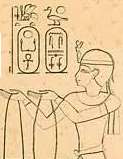Nastasen
| Nastasen | |||||
|---|---|---|---|---|---|
| Kushite King of Meroe | |||||
 Nastasen | |||||
| Burial | Nuri 15 | ||||
| Spouse | Queen Sakhmakh | ||||
| |||||
| Father | Harsiotef? | ||||
| Mother | Queen Pelkha | ||||
| ||||||||||||||||||||
| Nastasen - Ankhkare in hieroglyphs |
|---|
Nastasen was a king of the North African Nubian civilisation of Kush (335 - 315/310 BC). According to a stela from Dongola his mother was named Queen Pelkha and his father may have been King Harsiotef.[1] His successor was Aryamani.
Monuments
He is known from three types of objects. There is a stela with a long historical inscription, a silver handle of a mirror[2] and several shabti-figures. The mirror handle and the shabti were found in a pyramid at Nuri (Nu. 15), which was obviously his burial place. He was the last Kushite king to be buried in the royal cemetery at Napata.

The 1.63 m high granite stela was found at New Dongola and is now in the Berlin Museum Inv. no. 2268. Originally it was most likely placed in the Amun temple of Jebel Barkal. In the upper part appear the pictures and name of his mother Pelkha and his wife Sekhmakh, next to the king.
Conflict with Khabbash
During his reign, Nastasen defeated an invasion of Kush from Upper Egypt. Nastasen's monument calls the leader of this invasion Kambasuten, a likely local variation of Khabbash. Khabbash was a local ruler of Upper Egypt who had campaigned against the Persians around 338 BC. His invasion of Kush was a failure, and Nastasen claims to have taken many fine boats and other booty during his victory.[3]
References
Literature
- Fage, J.D. & Roland Oliver (1975). The Cambridge History of Africa Volume 2: From C.500 BC to AD1050. Cambridge: Cambridge University Press. pp. 858 Pages. ISBN 0-521-21592-7.
- Laszlo Török, in: Fontes Historiae Nubiorum, Vol. II, Bergen 1996, 467-501, ISBN 82-91626-01-4